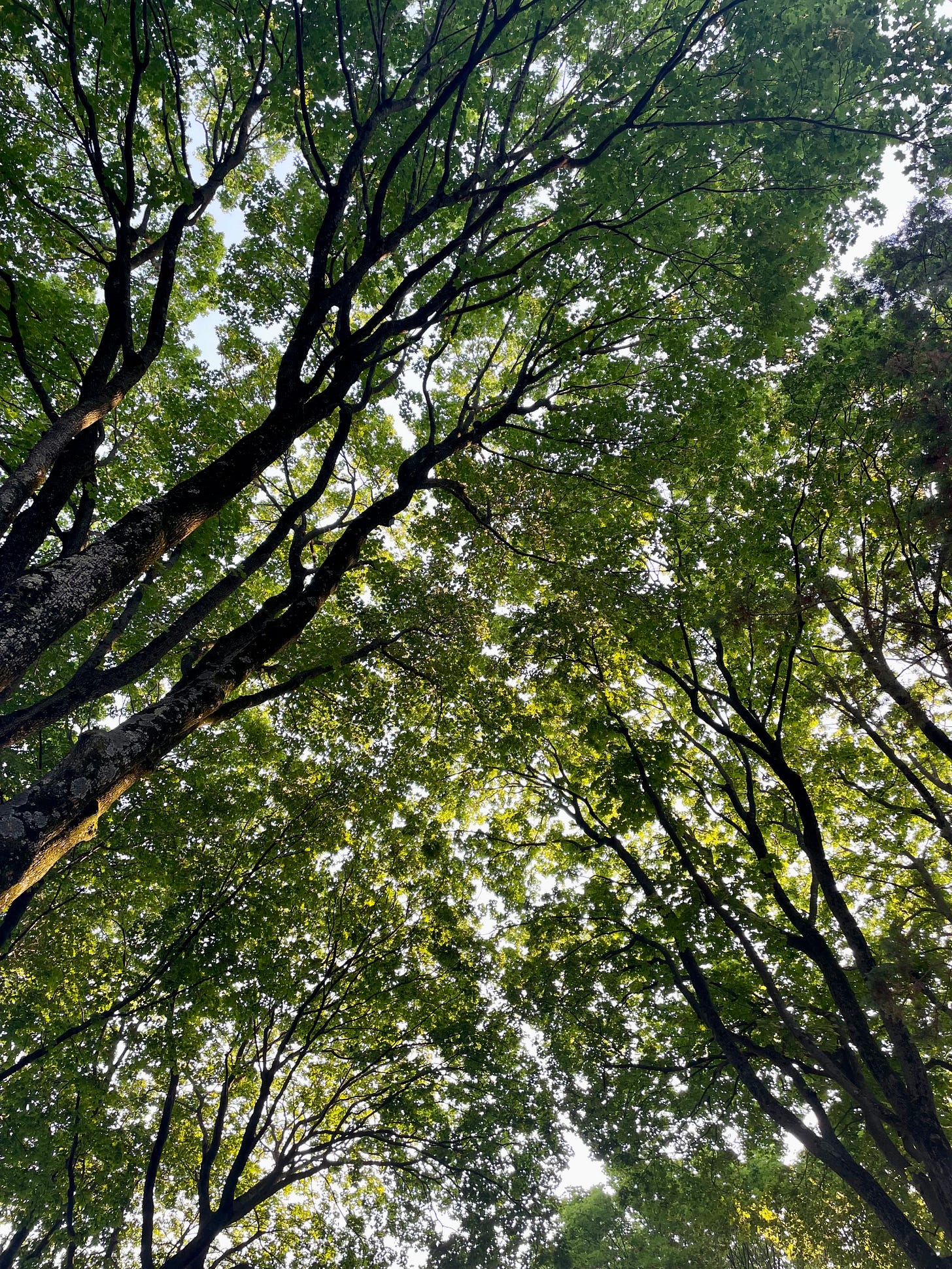Let's check in with my suburban bonsai
Preparing trees for the long haul; bonsai as a reflection of nature.
I’m in the suburbs this week helping my dad around the house after his knee replacement. His neighborhood is an old development with towering maple, spruce, and hemlock trees. Look up and this is what you see. Everything they say about the calming effect of trees is true. It’s a gift to live under a canopy.
I have two container trees camping out here that my stepmom diligently watches and waters. This dawn redwood is too large to dig into the Queens restaurant planters with my other outdoor trees, and has had some health problems in recent years. The trunk is about the same diameter as my other dawn redwood. I’d like it to be thicker, so I’ve decided to forgo bonsai training for the time being and let it grow wild.
This year’s fernlike foliage looks healthy. Don’t you want to run your fingers through it?
My other suburban container tree is an Eastern red cedar, one of my earliest bonsai purchases. I missed repotting season for it this year. Next spring it should be ready to transplant into bonsai soil. I want to take advantage of the ramrod-straight trunk to design a tall, slender tree that looks like a forest conifer on a mountain. For now it gets a hard trim to redirect vigor to the base of the trunk. It has the beginnings of branch structure, but like the dawn redwood, it will be a long time before it looks like anything impressive.
American bonsai people tend to look down on Eastern red cedar as a bonsai species, for what I’d consider mostly valid reasons. The foliage just doesn’t cooperate like junipers from the nursery trade, and you don’t find many good specimens among hobbyists. Still, it’s an abundant native tree with interesting bark and a tropical-fragrant foliage. I don’t have high hopes for it, but in the wide open space of the suburbs, I can enjoy it as a project on the back burner.
Two maple seedlings have germinated in my pots. Bonsai people call these pop-up plants “volunteers,” and it’s standard practice to prune or transplant them to their own container so their roots don’t compete with your main tree.
Here is one seedling in front of its likely parent, a chunky silver maple that would take three of me to hug it all the way around. Bonsai people say silver maples don’t make good bonsai either, but I might as well try growing them. It’s the suburbs! There’s space!
This is what I’m missing by practicing bonsai in an urban environment. All my experiences are so…retail. I don’t have room for experiments like free silver maples. There’s nowhere I can propagate cuttings or let wild-harvested trees recover. Many bonsai specimens begin as trees that are left alone to grow in a field for five years; I don’t have a balcony, let alone a field. Instead, I have to buy every tree semi-developed—and most of them online—from sellers who pack them for shipping with styrofoam.
Bonsai began as a way to capture the wild outdoors in miniature, as if you shrunk a forest to fit inside a snow globe. As much as I enjoy this practice, there’s no substitute for real gnarly trees above your head, with songbirds in their branches and seedlings taking root in whatever patch of soil they can find. I envy bonsai artists with yards and gardens to devote to their projects.
It’s not just about the breathing room. It’s about the opportunity to spend time with your trees as part of an ecosystem, rather than as isolated specimens in a zoo. Working with nature to get closer to nature, on its own turf, following its lead.
I don’t regret the choices that led me here. I’m a city mouse at heart with a fruit guy and a halal food cart on the same nearby corner. Still, the grass looks a lot greener out here in the suburbs. Maybe there’s another version of myself who could live in wide open spaces. Nature and I could get into good trouble together.
Tree reading
One quarter of New York City’s forest is in Staten Island, where underfunded park workers are responsible for managing 220 acres each. “Imagine if all of Central Park was forested; there would be only four people working there.” [SI Live]
Dig into this luscious story package about food-farming with trees. [Civil Eats]










This post resonates. My little trees generally start off with me in pots, and after a year or two, or three, graduate to something like niwaki status, as I find appropriate places for them. Some are boughten, and some gathered on the mountain like yamadori. I'm a cheerful pruner but I'm not a real bonsai, niwaki grower. Wiring, etc. seems rather brutal to me. But yes, a tree in the earth is more a tree, somehow, more allowing of deep conversation.
Wow, your dad’s place is lovely. Hope his knee’s better soon.
Great post Max.